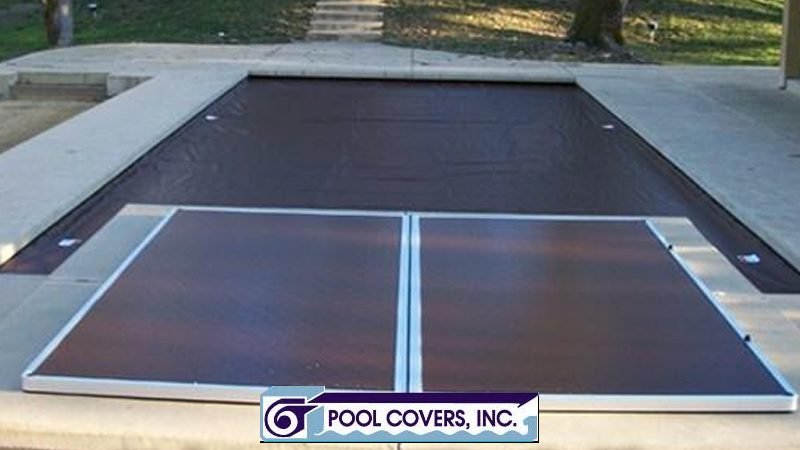
Automatic covers in Woodside may be built to last long. But like many other covers, they still require regular maintenance to extend their useful life.
Automatic pool covers are a popular feature on many backyard pools for the following reasons:
- Enhanced safety: Automatic covers are designed to support significant weight, providing a secure barrier that prevents children, pets, and wildlife from accidentally entering the pool. This feature is highly valued by families who prioritize pool safety.
- Ease of use: An automatic cover can quickly open or close with a simple button or switch, making it more convenient than traditional covers, which require manual handling and time to set up.
- Energy efficiency: When closed, an automatic cover helps reduce heat loss, keeping the pool water warmer. This can lower heating costs, especially for pools in cooler climates or at night when temperatures drop.
- Reduced water evaporation: The cover limits water evaporation, conserving water and reducing the need to refill the pool frequently, especially in hot and dry climates.
- Lower chemical usage: By reducing exposure to sun and wind, an automatic cover can help maintain chemical balance, minimizing chlorine loss and lowering overall chemical costs.
- Cleaner pool: A closed automatic cover removes debris like leaves, dust, and insects, reducing the time and effort needed to clean and maintain pool clarity.
Automatic covers add value and enhance the usability of backyard pools, making them a popular feature among homeowners who want a safer, lower-maintenance pool.
How to maintain your automatic pool cover
To continue enjoying your automatic pool cover’s benefits, you must regularly maintain it. Following these essential tips below can help prolong its lifespan, ensure safety, and keep your pool cleaner.
1. Regular cleaning
- Debris removal: Use a soft broom or leaf blower to regularly remove leaves, dirt, and other debris. Do this regularly. Accumulated debris can weigh down the cover, potentially damaging the motor and mechanisms.
- Cleaning the surface: Periodically hose down the cover and use a mild, non-abrasive cleaner. Avoid harsh chemicals that could weaken the cover’s material over time.
- Removing standing water: After rain or cleaning, use a cover pump to remove any standing water, as the weight can strain the cover’s mechanisms and fabric.
2. Lubricating the mechanisms
- Check for lubrication needs: Automatic pool covers often include tracks, ropes, and pulleys. Regularly lubricate these components to prevent rust and ensure smooth operation.
- Use manufacturer-recommended products: Only use lubricants specified by the manufacturer, as some substances may damage components over time. Check the owner’s manual for specific guidance.
3. Inspecting tracks and rollers
- Track alignment: Check the alignment of the cover tracks to ensure the cover opens and closes smoothly. Misalignment can lead to tearing or mechanical strain.
- Roller condition: Inspect the roller and guide pulleys for wear. Replace worn parts promptly, as a malfunctioning roller can cause uneven cover movement.
4. Regularly check the cover’s fabric for damage
- Identify tears and weak spots: Carefully inspect the cover for tears, weak spots, or fraying edges, as these can expand over time. If there are small tears, you can repair them with a patch kit, but more extensive damage may require professional repair or replacement.
- Preventing UV damage: Many pool covers are UV-resistant, but prolonged exposure can still weaken them. When not in use, consider partially retracting the cover to reduce constant exposure to sunlight.
5. Proper tension and positioning
- Adjust the cover tension: A loose cover may cause folds or wrinkles that hinder smooth opening and closing, while an overly tight cover can strain the motor and tracks. Follow the manufacturer’s guidelines on adjusting tension for your specific model.
- Avoid overextending: Ensure the cover is not overextended when closing, as this can damage the motor or cause the cover to stretch.
6. Control water chemistry
- Maintain balanced pH levels: High chlorine levels or an imbalanced pH can affect the material of your cover, leading to premature wear. Regularly test the water and keep chemical levels within recommended ranges.
- Shock carefully: When shocking your pool, retract the cover and keep it off for a few hours to avoid trapping strong chemical fumes that could weaken or discolor the cover.
7. Preventing snow and ice buildup
- Clear snow in winter: Snow accumulation can be particularly damaging to pool covers for those living in areas with colder climates. Light snow can usually be brushed off, but heavy snow or ice should be carefully removed, as its weight can severely strain the cover.
- Use a cover pump for melting snow: As snow begins to melt, a cover pump can prevent water from freezing on the cover and add an extra layer of protection.
8. Ensure safe operation
- Limit foot traffic: Automatic pool covers are designed to support some weight. However, it is best to minimize walking or placing objects on the cover as this can stress the cover material and motor.
- Teach safe usage: If others, especially children, operate the pool cover, ensure they understand the importance of safe operation, including not forcing the cover if it gets stuck and not using it as a play area.
9. Protect the motor from overuse
- Avoid over-cycling: The cover motor is not intended for frequent, rapid opening and closing. Give it time to cool down between uses, especially during peak pool season when the cover might be used multiple times daily.
- Schedule regular motor checks: The motor is a crucial component. Periodically, check it for signs of wear, unusual sounds, or delays in response. Early intervention can prevent costly repairs.
10. Professional maintenance
- Annual inspection: Consider hiring a professional for a yearly inspection. They can spot potential issues you might miss and handle more technical maintenance, such as motor adjustments, track repairs, and lubrication.
- Follow warranty guidelines: If your cover is under warranty, check the terms. Some warranties require periodic professional service to remain valid, and professionals can provide documentation of maintenance performed.
11. Seasonal storage tips
- Winter storage: For pools closed in winter, retract the cover fully, if possible, to protect it from ice and extreme temperatures. If leaving the cover over the pool, ensure it’s free from water and debris to avoid stretching or sagging.
- Summertime protection: If the cover isn’t frequently used during the summer, roll it up and store it in a shaded, dry area to protect it from continuous UV exposure.
Final words
Automatic pool covers in Woodside provide fantastic benefits, such as clean pool water, safety, energy savings, and convenience. Incorporating these maintenance tips into your regular pool care routine can help you extend the life of your automatic pool cover, keep it functioning well, and maintain a cleaner, safer pool area.
Don’t hesitate to contact our Pool Covers, Inc. team for professional assistance! Call us at 707-864-6674 or email us at customerservice@poolcoversinc.com.









